RDI in Redis Insight
Connect to RDI from Redis Insight, configure pipelines, and more.
Redis Data Integration (RDI) and its ingest pipeline capability is an end-to-end solution for mirroring your application's primary database in Redis. RDI employs a capture data change mechanism and a stream processor to map and transform source data such as relational tables into fast Redis data structures that match your use cases. You can read more about RDI's ingest architecture on these pages.
As of version 2.54.0, Redis Insight includes RDI connectivity, which allows you to connect to RDI management planes, create, test, and deploy RDI pipelines, and view RDI statistics.
Connect
Open Redis Insight and then click on the Redis Data Integration tab, which looks like this:
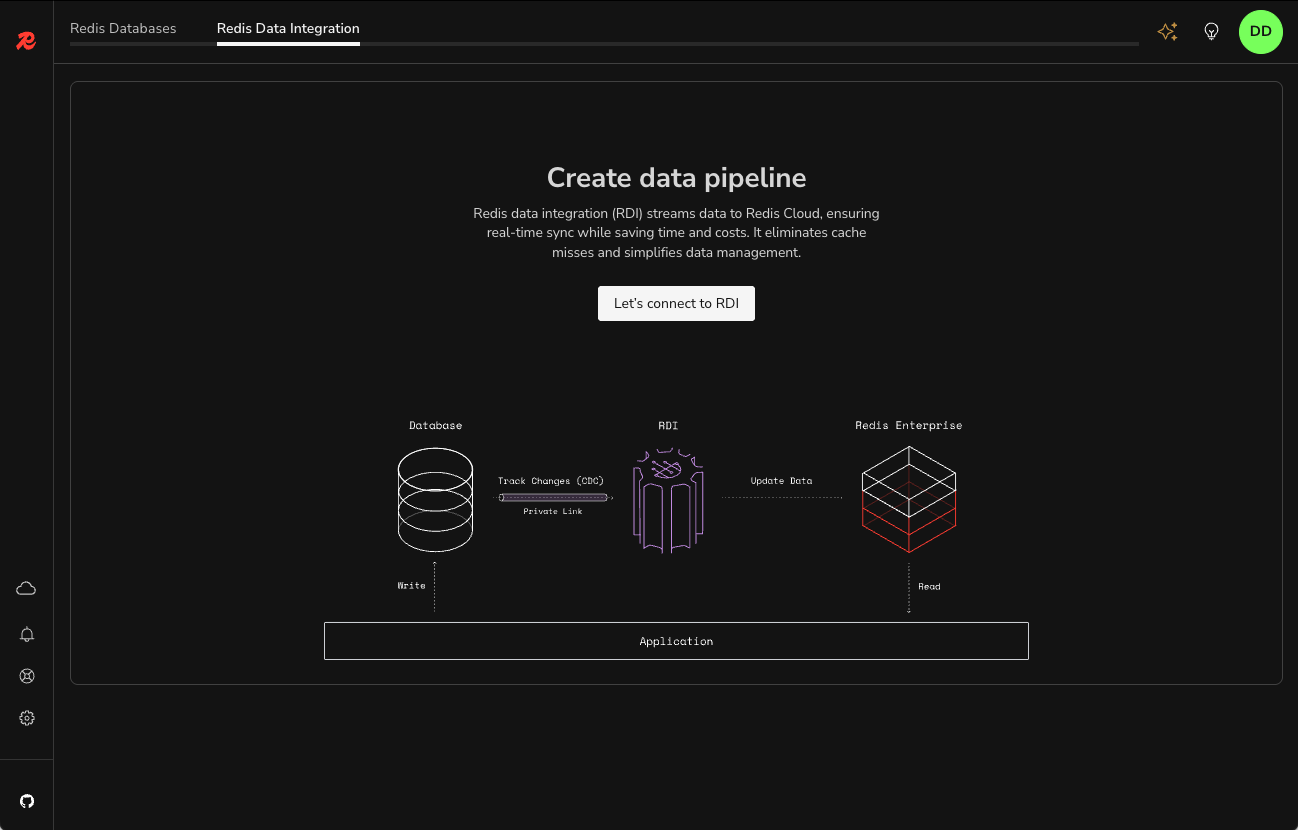
Next, click on Let's connect to RDI, which will open the Add RDI Endpoint dialog.
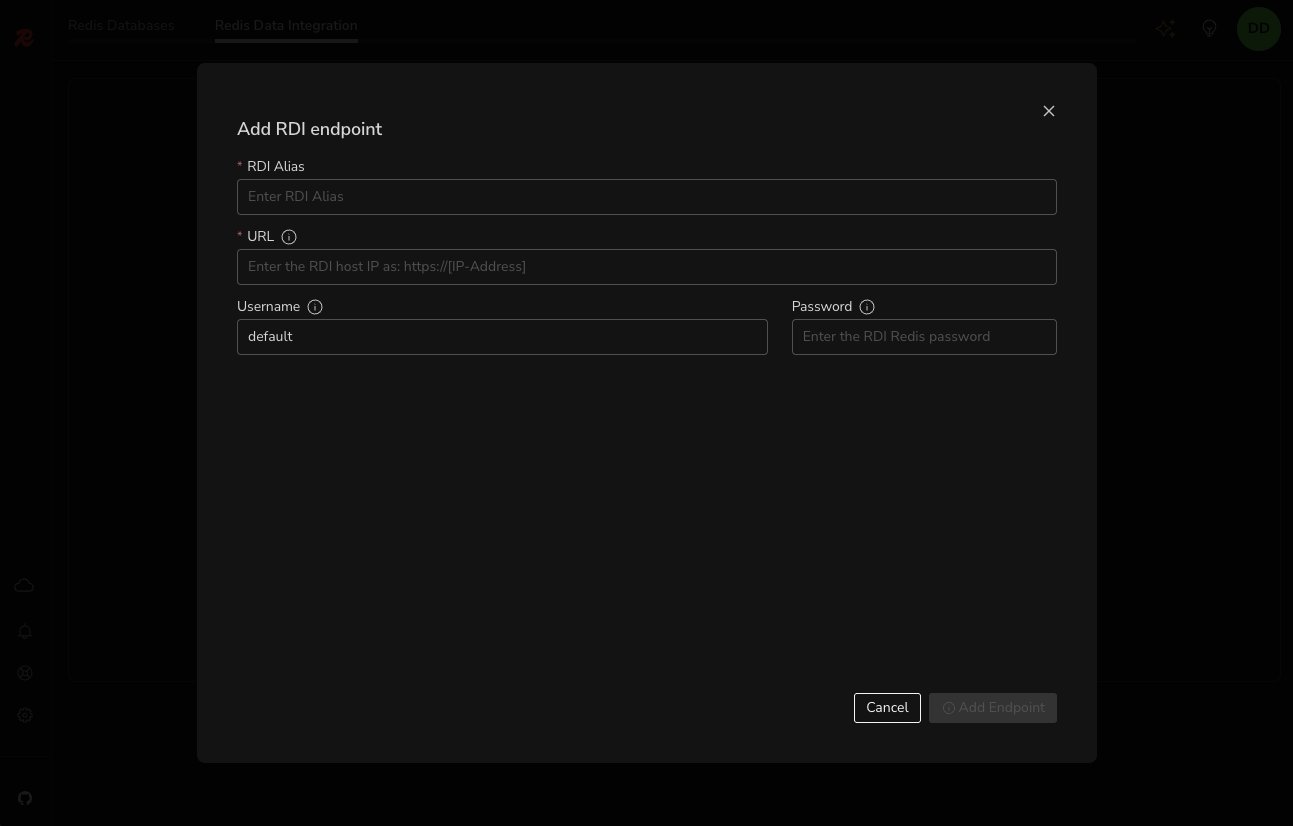
Enter your RDI server details into the dialog. The RDI Alias field can be any name you choose and it will be used as the primary name in the RDI Instances list view. You'll receive notification if your connection is successful.
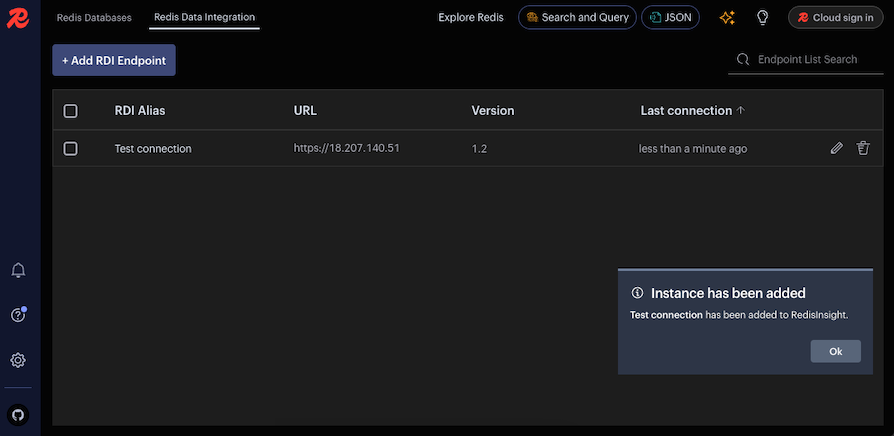
Create, test, and deploy RDI pipelines
Begin by clicking the alias of your newly configured RDI endpoint in the RDI Instances view (for example, Test connection in the above image). You'll see the following dialog in the center of the screen.
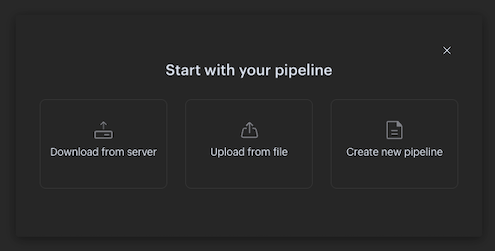
Choose from the following options:
- Download from server - Download an existing pipeline from your RDI configuration.
- Upload from file - Upload YAML pipeline files from your local computer in zip format.
- Create new pipeline - Use Redis Insight's built-in editors to create a new pipeline either from scratch or using one of the built-in templates.
Each of these menu options will be described in more detail in subsequent sections.
There are also equivalent buttons at the top of the editor pane for the first two of these functions.

If you'd rather start with an empty configuration, exit the dialog, which will leave you in the Configuration file editor where you can begin editing the configuration component of your pipeline; the config.yaml file.
Download a pipeline from your RDI configuration
Click the Download from server button in the Start with your pipeline dialog to download a previously defined pipeline from your RDI configuration. The downloaded pipeline will be displayed in the Pipeline management pane. As shown below, each pipeline consists of a configuration file (config.yaml) and zero or more job YAML files. The configuration file will be displayed in the center editor panel.

Upload a pipeline from your local machine
Click the Upload from file button in the Start with your pipeline dialog to upload your configuration and job YAML files from your local machine. The files must be stored in a zip file that has the following structure.
├── config.yaml
└── jobs
└── job1.yaml
The config.yaml file, your configuration YAML file, is required. The jobs directory can be empty, as job pipelines are not required, but the empty directory must exist in the zip file. Otherwise, the jobs folder might contain one or more job YAML files.
Create a new configuration file using the built-in editor
Click the Create new pipeline button in the Start with your pipeline dialog to create a new pipeline using the built-in editors. After doing so, you'll enter the Configuration file editor and you'll see an open Select a template dialog in the upper right-hand corner of the editor.

Make your selections in the provided fields:
- Pipeline type is set to Ingest by default.
- Database type has six options:
- mongodb
- cassandra
- mysql
- oracle
- postgresql
- sqlserver
After you make your selections and click Apply, Redis Insight will populate the editor window with an appropriate template. To start from scratch, click Cancel.
See the RDI documentation for information about required fields.
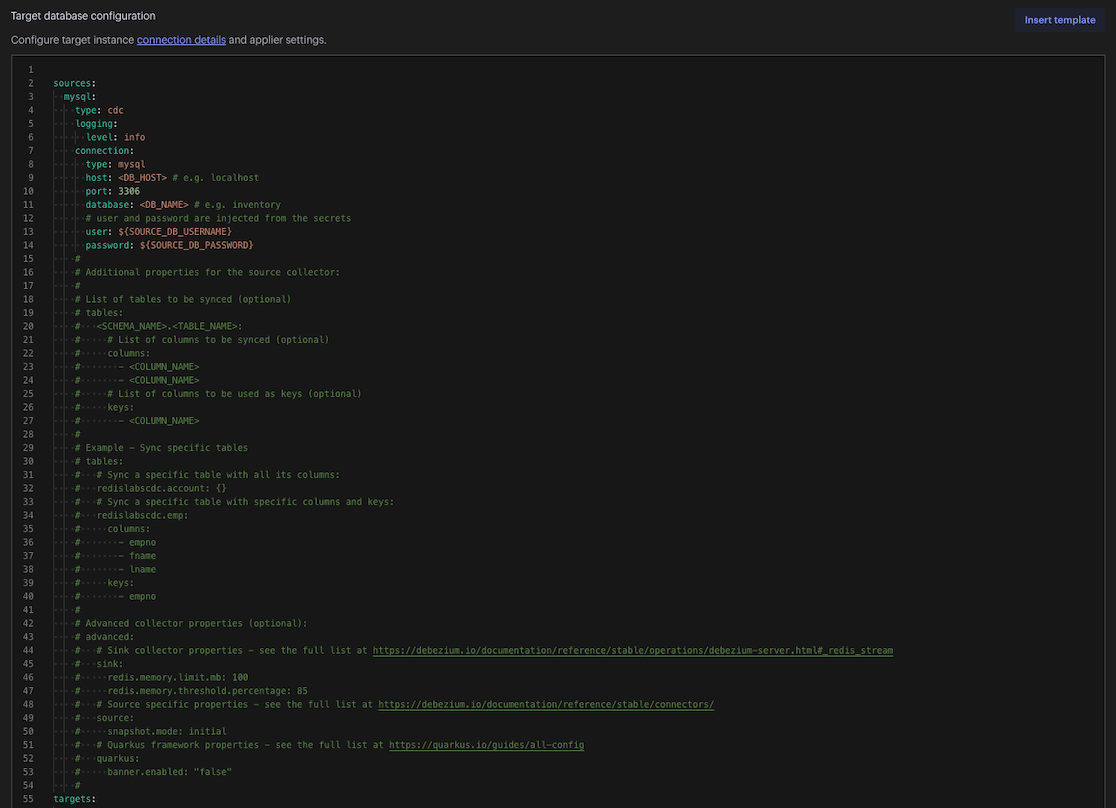
Test your target database connection
After you've created your Target database configuration, you can test the connection using the Test Connection button in the bottom right of the editor pane. A new panel will open to the right containing the test results as shown below.
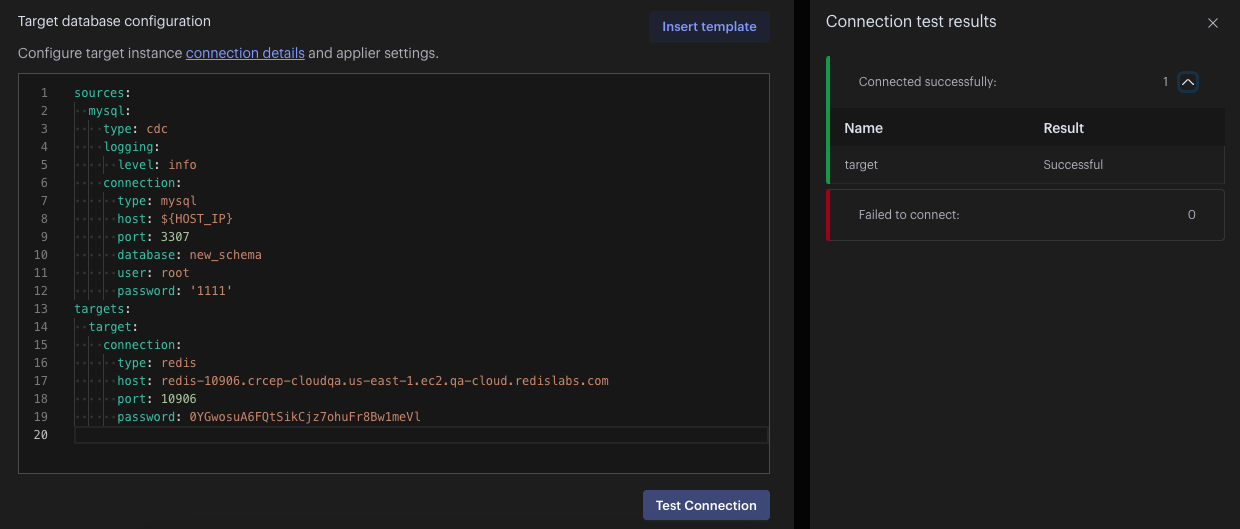
Create a new transformation job file using the built-in editor
In the Pipeline Management pane, click the + next to the Jobs folder and enter a name for the new transformation job.
Next, click the job name you just created.
This will take you to the job editor with the template selection menu open. Make your selection and click Apply. Redis Insight will populate the editor window with an appropriate template. To start from scratch, click Cancel.
The RDI documentation has several examples of transformation jobs that can help get you started. Note: RDI uses a very specific YAML format for job files. See here for more information.

Use the built-in editors
The Redis Insight pipeline file editors are context-aware. They provide auto-completion, syntax highlighting, and error detection for:
- YAML files in the configuration and job file editors
- JMESPath and SQL function snippets in a dedicated editor. To open the JMESPath and SQL editor, click the SQL and JMESPathEditor button as shown above. A new editor window will open in the lower half of the screen.
If you decided to write your own configuration pipeline without using a template, you would see auto-completion prompts such as the one shown below.
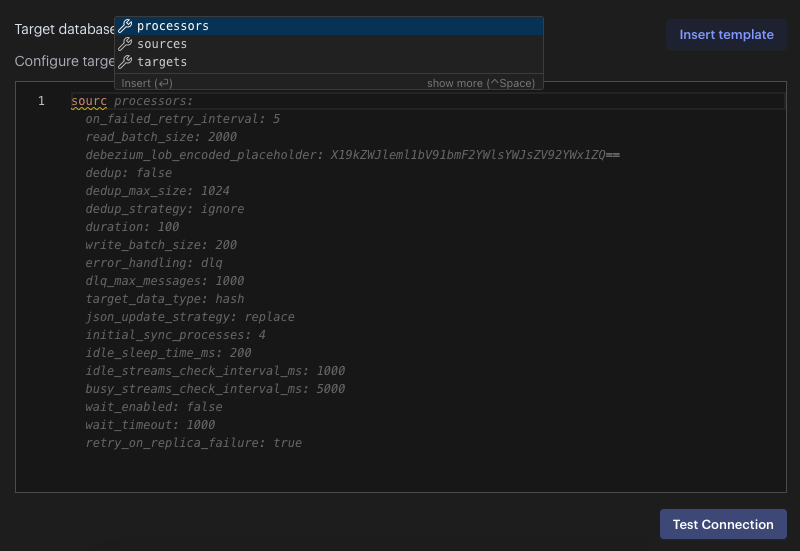
While this isn't a replacement for the RDI documentation, it can help speed you along after you have basic familiarity with the building blocks of RDI pipeline files.
Redis Insight will also highlight any errors as shown below.

Here's an example showing the SQL and JMESPath editor pane. Note the toggle in the bottom left corner of this editor pane. Clicking it allows you to select from:
- SQLite functions
- JMESPath
After constructing your SQLite or JMESPath code, copy it to the main editor window. Here's a reference to the supported JMESPath extension functions and expressions that you can use in your job files.

Any changes you make in the editors will be lost if you exit Redis Insight without saving your work. To save any changes you made to your pipeline files, deploy them to your RDI server (see below) or download the modified files as a zip file to your local disk using the Download button in the top right of the RDI window. Redis Insight will prepend a green circle on unsaved/undeployed files.
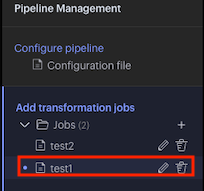
alt="Unsaved pipeline"
/>
Dry run transformation job pipelines
After you've created a transformation job pipeline, you can execute a dry run on the RDI server. To do that, click on Dry Run in the lower right side of the editor pane. A new Test transformation logic panel will open to the side. There are two vertically-stacked panes: Input and Results. In the Input section, enter JSON data that will trigger the transformation. Any results will be displayed in the Results section.
There are two tabs in the Results section:
- Transformations - this is where you'll see JSON output from your dry run.
- Output - (not shown) this is where you'll see the Redis commands that would have been run in a real scenario.
Here's an example.
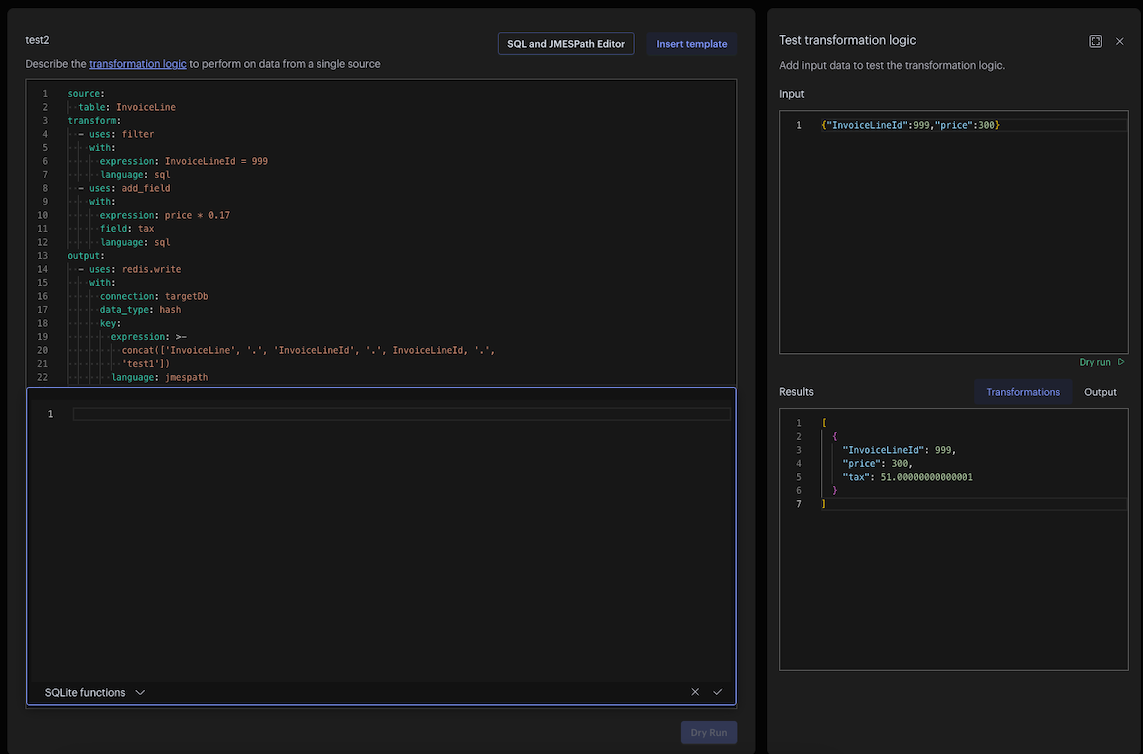
Deploy pipelines and add target DB to Redis Insight
If you're satisfied with your configuration and transformation job pipelines, you can deploy them to the RDI management plane. Click the Deploy Pipeline button to proceed.
After your pipelines have been deployed, you can add the RDI target Redis database defined in your config.yaml file to Redis Insight.
Doing so will allow you to monitor key creation from your RDI pipeline over time.
View RDI statistics
You can view various statistics for your RDI deployment. To do so, click the Pipeline Status menu button in the left side menu panel.
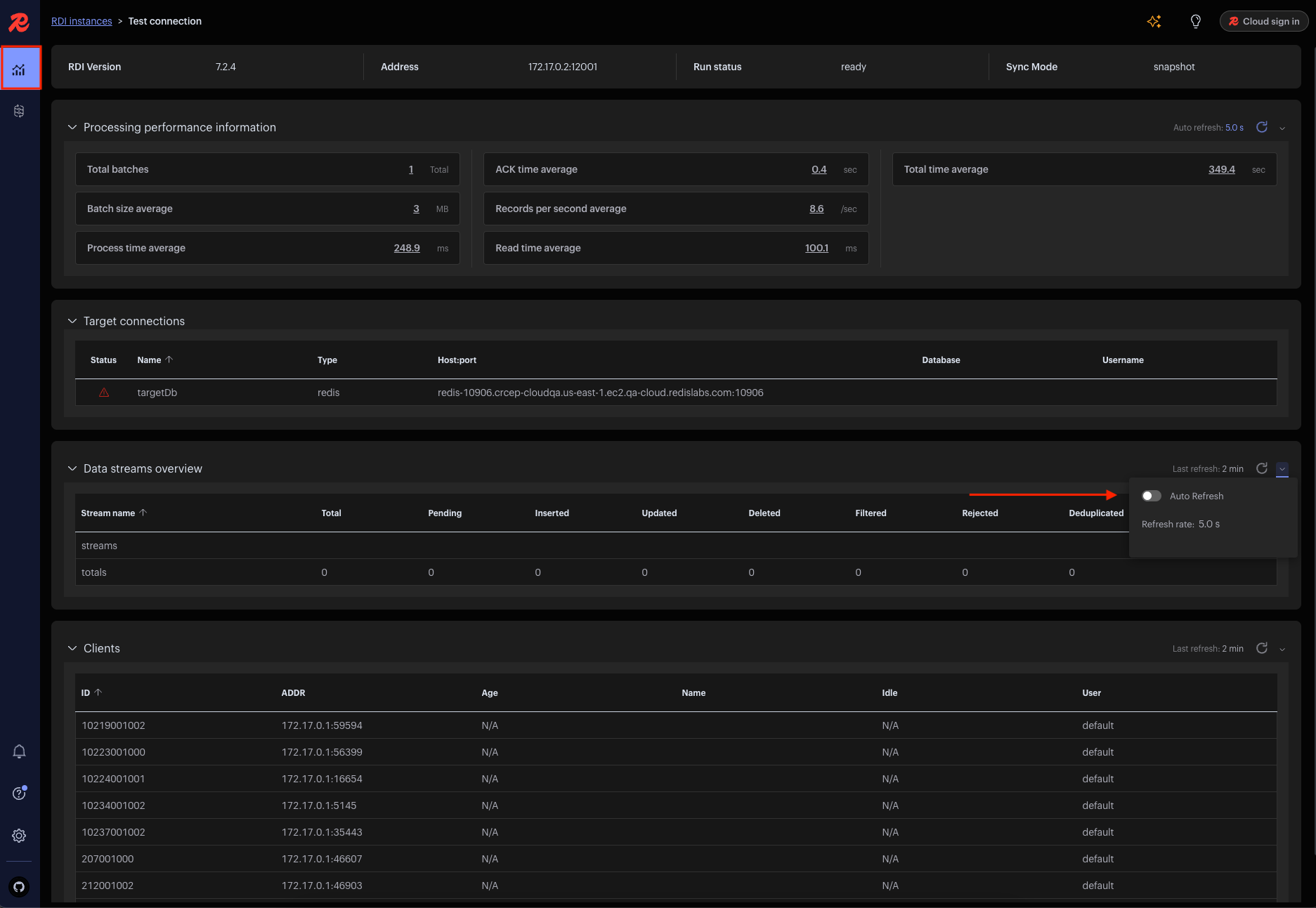
Each statistics section is either static or refreshed automatically at a particular interval that you set. The first section, Processing performance information is set by default to refresh every 5 seconds. The other sections are static and need to be refreshed manually by pressing the refresh button at the top right of each section. You can also set up automatic refresh for the other sections.
To set up automatic refresh for one or more statistics sections, click on the downward arrow at the end of the Last refresh line. Then enable the Auto Refresh setting and set your desired refresh interval in seconds. This is shown in the previous image.